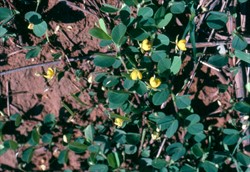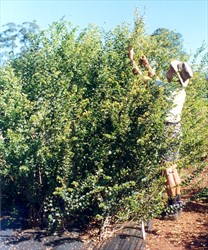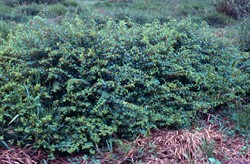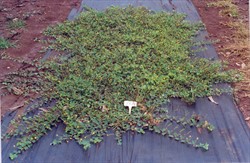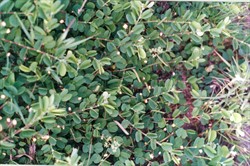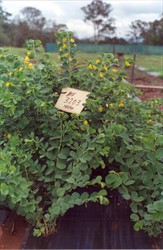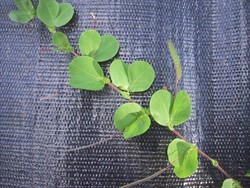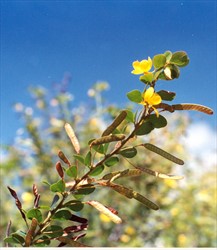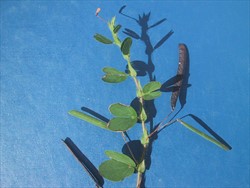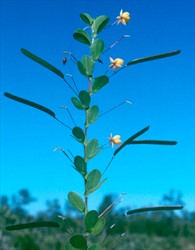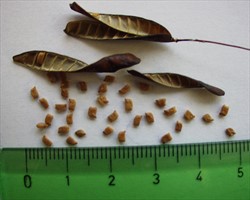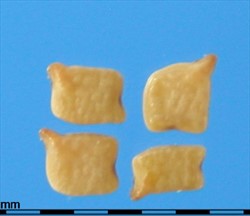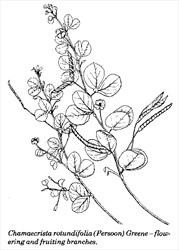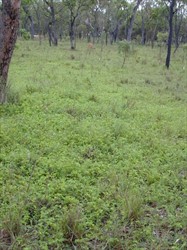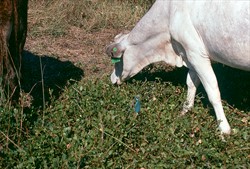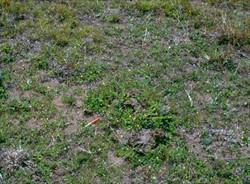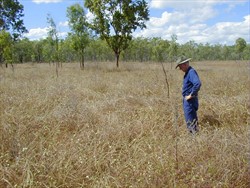Chamaecrista rotundifolia
Tropical Forages
Chamaecrista rotundifolia (Pers.) Greene
Subordinate taxa:
Chamaecrista rotundifolia (Pers.) Greene var. grandiflora (Benth.) H.S. Irwin & Barneby
Chamaecrista rotundifolia (Pers.) Greene var. rotundifolia
var. rotundifolia: Basionym: Cassia rotundifolia Pers.; Cassia bifoliolata DC. ex Collad.
var. grandiflora: Basionym: Cassia rotundifolia var. grandiflora Benth.; Cassia bauhiniifolia Kunth; Chamaecrista bauhiniifolia (Kunth) Gleason
Family: Fabaceae (alt. Leguminosae) subfamily: Caesalpinioideae tribe: Cassieae subtribe: Cassiinae.
Perennial or self-regenerating annual (in areas with heavy frost or long dry season); prostrate herb when young, suffrutescent with age; variable in width of plant and size of foliage, stipules and flowers; main stem erect to about 1 m high (rarely to 2.5 m), and laterals ascendant; taproot mostly to about 1 cm diameter. Stems pubescent to subglabrous, 45‒110 cm long, not rooting at nodes. Leaves ascending, bifoliolate, nictinastic; stipules lanceolate-cordate 4‒11 mm long; petioles 3‒10 mm long, eglandular. Leaflets asymmetrically subrotund to broadly obovate, rounded apically, 5‒55 mm long, 3‒35 mm wide, often mucronulate; venation slightly prominent on both surfaces; petiolule reduced to thickened pulvinule. Flowers in racemose axillary clusters of 1‒2 (‒3) flowers. Pedicels filiform, straight, from very short to three times the length of the leaves. Sepals greenish or reddish-brown, lanceolate, usually ciliate, up to 5 mm long. Petals bright (rarely pale) yellow, obovate, up to 6 mm long, glabrous, sessile. Fertile stamens 5, somewhat unequal, filaments very short. Anthers linear-oblong, up to 2 mm long, essentially glabrous and erostate, dehiscent by paired terminal pores. Ovary pubescent. Pedicel more or less filiform, 14‒78 mm long. Pod linear-oblongoid, straight or slightly curved, (15‒) 20‒55 (‒60) mm long, 2.5‒5.0 (‒6.0) mm wide, flat, blackish-brown when ripe, elastically dehiscent, seeds obliquely transverse. Seeds rhomboid to rectangular, flattened, pale brown, 2‒3 mm long. 200,000‒470,000 seeds/kg.
Cv. Wynn has broad leaflets, 15‒22 mm wide, long pods, 38‒40 mm long, and small seeds (253,000/kg).
var. rotundifolia: flowers small, largest petal to 7 mm long; 5 fertile stamens, longest fertile anther to 4.4 mm, style to 2 mm long.
var. grandiflora: flowers larger, largest petal to 17 mm long, 5‒7 fertile stamens (1‒2 very small often with 1‒3 staminodes), longest fertile anther to 11.5 mm, style to 8.5 mm long.
Asia: 圆叶决明 yuan ye jue ming (China); muôn’g lá tròn (Vietnam)
English: round-leaf cassia; round-leafed cassia; roundleaf sensitive pea
Latin America: acácia-rasteira, alfafa nativa, coração, erva-de-coração, fedegoso (also applied to Senna alata (L.) Roxb. and Senna occidentalis (L.) Link), mata pasto, pasto rastiero (Brazil); pega pega chiquita (Venezuela)
var. grandiflora
Native:
Central America: Honduras
South America: Argentina (Corrientes); Bolivia; Brazil; Colombia; Ecuador (Guayas); Guyana; Paraguay; Venezuela
var. rotundifolia
Native:
Northern America: Mexico
Caribbean: Cuba; Jamaica; Puerto Rico
Central America: Costa Rica (Alajuela, San José); Panama (Chiriquí)
South America: Argentina; Bolivia; Brazil; Colombia; Paraguay; Uruguay; Venezuela
Naturalized:
Northern America: U.S.A. (Florida)
Africa: Nigeria (?) (CPI 78916 was collected in the late 1970s on the Mokwa Ranch, Niger State)
Forage
Sown into native pastures to augment feed quality and occasionally sown into pastures of improved grasses. Limited value for conservation or standing hay because of substantial leaf drop under dry conditions, leaving woody indigestible stem. Has been made into good quality 'haylage' by baling Digitaria milanjiana/C. rotundifolia herbage at 40% moisture content and wrapping in plastic sheets. Has been successfully trialed for use in cut-and-carry systems in southern China.
Environment
Successfully trialed for use as a ley or phase legume in crop-livestock systems in Nigeria where its use resulted in improved cereal production. Could be used as a soil stabiliser on appropriate soils.
Var. rotundifolia is found in savannas and forests and is considered to be a rather aggressive weed in crops and paddocks.
Var. grandiflora inhabits plains, usually in sandy soil, on banks of rivers or beaches, not in association with var. rotundifolia.
Soil requirements
Free-draining light soils of low to moderate fertility. Most accessions have been collected from acid soils, but a small number originate from neutral or slightly acid soils. Very well adapted to acid infertile red soils of central southern China. Some Brazilian accessions have demonstrated high tolerance of acid soils with high Al saturation. Can persist for 1 or 2 seasons in less friable soils, but fails to regenerate despite seed-set.
Moisture
Behaves as a perennial under 900‒1,500 mm rainfall; as an annual down to 600 mm. One of the best adapted legumes on sandy soils in semi-arid northern South Africa and in semi-arid west Africa. Does not tolerate poor drainage or flooding. Reasonably drought-tolerant when plants form rosettes under heavier grazing, but leaves often turn red and drop if plants are left ungrazed and tall during dry conditions. Has been collected from sites with rainfall ranging from 400 to 3,700 mm, but most are in the 800‒1,500 mm range.
Temperature
Warm season growth only; top growth readily killed by frost. Under regular heavy frosts, round-leaf cassia behaves as an annual. There were large differences among accessions in survival over winter in subtropical China (26‒29º S), with only those from the most extreme southern origins (Paraguay and Argentina) surviving.
Light
Full sunlight to moderate shade. Shows promise in silvopasture development.
Reproductive development
There is a strong relationship between the latitude of provenance and flowering date, growth and canopy height. Accessions from low latitudes tend to be late flowering and tall; those from higher latitudes are earlier flowering and smaller; e.g. accessions collected in low latitudes in N Brazil (7° S) flower late in the growing season in the subtropics, whereas cv. Wynn, collected about 23° S flowers throughout the growing season in the same environment. Var. rotundifolia flowers from November to April in Rio Grande do Sul, Brazil. Soil seed reserves can reach 1,000‒1,200 seeds/m2.
Defoliation
Very tolerant of constant heavy grazing. However, if allowed to grow tall and then cut low, individual plants fail to regenerate, although populations will regenerate from seed reserves.
Fire
Some plants persist but most regeneration is primarily from soil seed reserves.
Guidelines for establishment and management of sown forages.
Establishment
Although there have been reports of high levels of hard seed, mechanically harvested seed rarely requires further scarification. However, seed must not be treated with hot water to break dormancy as it becomes mucilaginous and aggregates. Seed germinates quickly after rainfall; seedlings grow rapidly and early-flowering types can flower within 6 weeks. Round-leaf cassia appears to nodulate readily with native rhizobia.
Fertilizer
Responds to phosphorus and sulphur on low-fertility soils.
Compatibility (with other species)
Combines well with native tussock grasses and more open creeping naturalized grasses, but can become dominant if stock concentrate on more palatable companion grasses in early and mid-growing season. Can improve the protein level of associated grasses.
Companion species
Grasses: Bothriochloa pertusa, Chloris gayana, Digitaria eriantha, Urochloa mosambicensis and a range of other grasses.
Legumes: Aeschynomene falcata, Listia bainesii, Stylosanthes guianensis var. intermedia.
Pests and diseases
No known insect attack or serious fungal disease in Australia. Anthracnose (Colletotrichum spp.), foliar spots (Phomopsis spp.) and foliar blight (Rhizoctonia solani) seen in Central and South America. Anthracnose has been very destructive on new accessions in the Brazilian savannas. Foliar blight is more serious in regions receiving 2,000 mm AAR. Recorded as a host for alfalfa mosaic virus in Africa and some accessions attacked by anthracnose in West Africa. Recent studies in the USA have shown the species is more susceptible to a wider range of fungal pathogens than was first realised.
Ability to spread
Will spread naturally through heavy seed set.
Weed potential
Due to its massive seed set and low seasonal palatability, C. rotundifolia is considered a weed or a potentially serious weed in some areas. It is probably best not used for green manure or as an intercrop species in low growing crops, particularly in sandy soils.
Nutritive value
Nutritional value as good as Medicago sativa in rat-feeding trials. Good protein and digestibility levels recorded under grazing. Application of deficient P and S in southern Queensland increased N concentrations of leaf tips to 3.3% N.
'Wynn' cassia raised N concentrations of companion native grass (Heteropogon contortus ) by 20-40% under grazing and fertilizing (with P & S).
Palatability/acceptability
Generally not eaten readily by cattle in the growing season under higher rainfall conditions, but becomes more acceptable as the associated grasses mature later in the season. Can comprise up to 20% of diet in late autumn. While there is little apparent problem with 'Wynn' cassia in lower rainfall areas (<900 mm), later maturing, taller types can be rejected by stock. It is therefore essential that palatability of accessions that have been selected on the basis of adaptation and yield is tested prior to general release. 'Wynn' is not eaten by horses.
Toxicity
No known anti-nutritional factors in C. rotundifolia.
Feedipedia link
April 2020: Page under construction
Dry matter
DM yields of up to 7 t/ha have been recorded, although yields of 3‒5 t/ha are more common. Large ecotypes of both varieties may be capable of consistently high yields.
Animal production
In Australia, oversowing cv. Wynn into native pasture of Heteropogon contortus increased LWG /head of steers stocked at 2.4 ha/head by 34 kg/yr (40% improvement) or by 45 kg/yr when fertilized with P and S.
Mostly diploid, 2n = 16, although chromosome numbers of 14 and 32 have been reported.
Very heavy seed set, but seed ripens over an extended period and shatters. Yields of 800 kg/ha have been obtained under suction harvesting in Australia.
Susceptible to 2,4 -D and to aciflourfen; moderately tolerant of fluazifop-butyl and sethoxydim.
- Rapid establishment and spread.
- Low fertility demand.
- Adapted to acid soils.
- High seed yields.
- Low palatability.
- Poor drought tolerance if ungrazed.
- Susceptible to anthracnose in the South American savannas.
Hacker, J.B., Wen Shilin, Ying Zhaoyang and Pengelly, B.C. (2001) Selecting Chamaecrista spp. for stabilisation and forage in southern China. Tropical Grasslands 35:96–113. bit.ly/2UleaPv
Jones, R.M. (1992) Chamaecrista rotundifolia (Persoon) Greene. In: Mannetje, L.’t and Jones, R.M. (eds) Plant Resources of South-East Asia No. 4. Forages. Pudoc Scientific Publishers, Wageningen, the Netherlands. p. 86–88. edepot.wur.nl/327785
Lenné, J.M. and Trutmann, P. (eds). (1994) Diseases of Tropical Pasture Plants. CAB International, Oxon, UK.
Minggang, X. McDonald, C.K., Liu, C.J. and Hacker, J.B. (2000) Variation in temperature requirements for germination and early seedling root development in Chamaecrista rotundifolia and three allied species. Genetic Resources and Crop Evolution 47:25–34. doi.org/10.1023/A:1008775221573
Partridge, I.J. and Wright, J. (1992) The value of round-leafed cassia (Cassia rotundifolia cv. Wynn) in a native pasture grazed with steers in south-east Queensland. Tropical Grasslands 26:263–269. bit.ly/33U5GlF
Pengelly, B.C., Maass, B.L., Thomas, B.D. and Hacker, J.B. (1997) Origin of the world’s collection of the tropical forage legume Chamaecrista rotundifolia. Proceedings of the XVIII International Grassland Congress, Winnipeg & Saskatoon, Canada, 8–17 June 1997. p. 25–26.
Pott, A. (2016) Chamaecrista rotundifolia (Erva-de-coração). In: Vieira, R.F., Camillo, J. and Coradin, L. (eds) Espécies Nativas da Flora Brasileira de Valor Econômico Atual ou Potencial: Plantas para o Futuro ‒ Região Centro-Oeste. Secretaria de Biodiversidade, Ministério do Meio Ambiente, Brasília, DF, Brazil. p. 513‒516. https://bit.ly/2UMZUzo
Strickland R.W., Greenfield, R.G., Wilson, G.P.M. and Harvey, G.L. (1985) Morphological and agronomic attributes of Cassia rotundifolia Pers., C. pilosa L., and C. trichopoda Benth., potential forage legumes for northern Australia. Australian Journal of Experimental Agriculture 25:100–108. doi.org/10.1071/EA9850100
Tarawali, S.A. (1994) The yield and persistence of selected forage legumes in subhumid and semi-arid west Africa. Tropical Grasslands 28:80–89. bit.ly/2vS9tU0
Tarawali, S.A. (1995) Evaluation of Chamaecrista rotundifolia accessions as a fodder resource in subhumid Nigeria. Tropical Grasslands 29:129–133. bit.ly/2UJgYFl
Tarawali, S.A. and Peters, M. (1996) The potential contribution of selected forage legume pastures to cereal production in crop-livestock farming systems. The Journal of Agricultural Science 127:175–182. doi.org/10.1017/S0021859600077959
'Minyin' (CPI 86134) Released in China 2005. Origin near Guadalajara, Jalisco, Mexico (20°45' N, 1,500 m asl, rainfall 900 mm) Hay yield of 9.4‒11 t/ha and seed yield of 140‒280 kg/ha, which were 130% and 77 % higher than those of cv. Wynn. CP level of 17% harvested at full blooming stage. Rapid establishment on red soils in Fujian and Hunan Provinces. Selected for use in hilly red soils in tropical and sub-tropical China.
'Minyin 2' (ATF 3248) Released in China 2011. Origin near Florencia, Caquetá, Colombia (1°16' N, 300 m asl, rainfall 3,520 mm). Selected from 41 Chamaecrista spp.accessions for use on hilly red soils in the tropical and subtropical region of China. Hay yield 12‒15 t/ha and seed yield 200‒400 kg/ha, 28% and 25% higher than cv. Minyin. CP level harvested at full bloom stage was 16.9%.
'Minyu No. 1' Released in China 2011. Bred and selected for use in red soil regions of Southern China by Agricultural Ecology Institute of Fujian Academy of Agricultural Sciences, improved mutant strain from Ch. rotundifolia cv. Minyin through 60Cs γ-rays irradiation. Hay yields of 10‒15 t/ha and seed yield of 220‒320 kg/ha, 21% and 9% higher than cv. Minyin. CP level of 19.15% harvested at initial blooming stage.
'Wynn' (CPI 34721). Released in Australia 1984. Origin Valinhos, São Paulo, Brazil (22°54' S, 600 m asl, rainfall 1,306 mm). Selected for use in beef grazing systems in the subtropics of Queensland.
BRA 000183, BRA 000205 (origin Colombia). Selected at Bragantina, Bragança region, Pará, Brazil (1°04' S) on acid, low fertility, yellow latosol (Oxisol), without fertilization. BRA 000183 = CIAT 7792, var. grandiflora, can grow to 2.5 m tall.
CIAT 8156, CIAT 8158 (origin Colombia); CIAT 8391, CIAT 8992, CIAT 17000, CIAT 17001 (origin Brazil). Selected in Colombia for very acid, high Al soils.
ILCA 14165 (CPI 49713 Brazil), ILCA 14167 (Q 9862 Brazil). Selected for yield and quality at Kurmin Biri, Kaduna State, Nigeria (10°10' N), subhumid environment, infertile, ferruginous soil. ILCA 14167 most promising.
ILCA 14172 (CPI 78916 unknown), ILCA 14174 (CPI 52092 unknown). Selected for dry season production at Kurmin Biri, Kaduna State, Nigeria (10°10' N), subhumid environment, infertile, ferruginous soil.
ATF 3203, ATF 3253 Origin 13°38' S in Brazil 2°45' N in Brazil respectively. High yielding for annual cut-and-carry systems but low winter survival on red soils of southern China.
ATF 2228, ATF 2230, ATF 2231 Better cold-tolerance, early-flowering types which originate from 26° to 27° S in Paraguay. Higher winter survival made these most promising for soil stabilisation in orchards in red soils region of southern China.
Q 9862 (origin Teixeira, Paraíba, Brazil, 7°8' S, rainfall 737 mm, semi-arid), Q 10057 (origin São João do Cariri, Paraíba, Brazil, 7°22' S, semi-arid). Selected in Australia. Large plants, very late flowering; persistence limited by time of onset of frost.
CPI 85836, CPI 86172 (Mexico); CPI 92931, CPI 93094 (Brazil). Selected in Australia Later flowering and taller types than 'Wynn'.
CPI 37234 (Tequila, Jalisco, Mexico, 20°52' N, 1,280 m asl, rainfall 984 mm). Selected in NSW, Australia. Similar in stature to previous accessions, and similar flowering behaviour to 'Wynn'.
